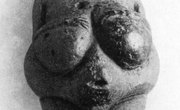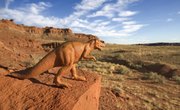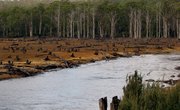The Tertiary Period falls within the Cenozoic Era. The period itself lasted over 63 million years and contained five separate epochs: the Paleocene, the Eocene, the Oligocene, the Miocene and the Pliocene. Mammals thrived during this period after the extinction of the dinosaurs in the Cretaceous Period. Categorizing some of these Tertiary Period animals by epoch can be helpful in remembering where they emerged within the overall time period.
The Paleocene Epoch
Around 65 to 55 million years ago, the Paleocene Epoch saw the formation of the ice caps and the subsequent development of a cooler climate. With the dinosaurs extinct at this point, mammals had begun to grow in diversity and population. Early primates and rodents also appeared during this time period. The Paleocene Epoch also saw the emergence of the ancestors of present-day herbivores with hoofs that thrived on Tertiary Period plants.
The Eocene Epoch
During the Eocene Epoch around 55 to 34 million years ago, the continents of Europe and North America diverged and the oldest fossils of present-day mammals appeared. During this age epoch, emerging animals included the ancestors of elephants as well as bats and whales. The first horse, Eohippus or "Dawn Horse", also entered the stage but was much smaller than current horses at only one to two feet high.
The Oligocene Epoch
Approximately 34 to 23 million years ago, the Oligocene Epoch of the Tertiary time period encompassed many geological events and a large quantity of new mammals entered the world. While Antarctica and Australia separated, India and Asia collided and thrust the Himalayas into existence. Incidentally, man's best friend arrived before man himself. The earliest forms of pigs, cats and dogs are thought to have arrived during the Oligocene Epoch. Additionally, sea levels were relatively low and contributed to the arrival of the the first toothed whales.
The Miocene Epoch
Occurring around 23 to 5 million years ago, the climate warmed significantly during the Miocene Epoch. During this window of time, Africa thrust into Europe causing the formation of the Alps. Primates and other such creatures emerged in greater number during this time period. Horses continued to develop and early camels and rhinos came onto the scene.
Pliocene Epoch Age of Mammals
Between 5 and 1.8 million years ago, the Pilocene Epoch marked an important time in the age of mammals. As South America and North America converged at Panama and Africa boxed out the Mediterranean Sea, the geography of the world began to strongly resemble our current-day geography. As the earth dried and cooled, grasslands spread and grazing mammals diversified. During this time, it appears that the ape lines and human lines also parted.











